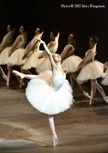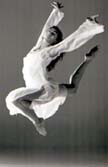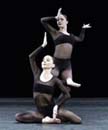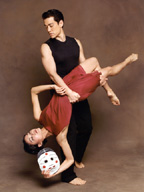ABT's City Center Season
Letter from New York
10 November 2003.
American
Ballet Theatre is winding up its fall season at City Center as I write,
and although the company still looks imbalanced in favor of its men, it
does seem to be trying to strengthen its repertory for the women, and
one could discover a host of brilliant performances on both sides of the
gender gap. To my eye, the most memorable ballerina triumph was Amanda
McKerrow’s debut as Hagar in Tudor’s Pillar of Fire.
McKerrow didn’t perform steps; she built a character. From the opening
moments, sitting alone on the steps of her house, her limbs trapped shut
as her face began to open, her dance-acting sustained a subtle tension
and an animal intuition that gave the impression she was living the role.
It isn’t clear how long McKerrow will stay with A.B.T.: she has
publicly voiced dissatisfaction that she isn’t given enough to do
there, and the programs bear her out. This season, in addition to two
performances as Hagar, she danced one performance of the adagio from Tudor’s
The Leaves Are Fading with her husband, former A.B.T. soloist
John Gardner. (Tudor, himself, coached her in this role.) McKerrow is
the finest stylist in the title role of Giselle the company has, yet she
rarely gets to dance that at the Met, where A.B.T. programs its evening-length
classics. At City Center, where it can take more chances with new works
and older repertory that would be swallowed up in the vastness of the
Lincoln Center theater, McKerrow’s name is still rare on the bill.
Among recent guest choreographers, only Mark Morris, in Gong, has
seemed willing to use her; he did so with insight, presenting her in a
landscape of snowy reverence that showcased her meditative spirit and
crystalline execution of the classical vocabulary. As her Hagar showed,
McKerrow speaks more dance languages than that of pure classicism, however
it is true that she has to be presented in a special context, where her
silvery style and filament silhouette register as positive qualities.
At this point, A.B.T. offers few ballets of any kind in which the aristocratic
elements of McKerrow’s mastery wouldn’t get lost. Balanchine’s
Theme and Variations and Ashton’s Symphonic Variations
would seem obvious candidates. Both enjoyed marvelous productions
this season, all casts triumphant. However, she wasn’t chosen for
either of them. (For comments by A.B.T. ballet master Kirk Peterson, who
restaged Theme and Variations for the company this past summer, please
scroll down.)
read letter
ABT Winds Down with Fireworks, But Dorian Still Seems Silly
Contemporary
Works and Family Friendly Matinee
American Ballet Theater
City Center
New York, NY
November 6 and 9, 2003
by Eric
Taub
You have to love kiddie matinees. At last Sunday's Family Friendly matinee (the last of ABT's very successful season at City Center), I couldn't help but overhear (along with half the people in my row) the tyke behind me exclaim to her mother as Marcelo Gomes danced the pas de deux in Fancy Free with Julie Kent, "Mommy, he's wearing a thong under his pants. I can see it!" During Gomes' rendition of the third sailor's rhumba, this budding dance critic delivered the verdict: "That's disgusting!" (Considering what kids are exposed to on TV every night, this seems a bit extreme.)
In Theme
and Variations, Michele Wiles danced with the strength and generosity
she's shown throughout this season. She's not a retiring waif, and this
ballet calls for a dancer with presence and brilliant technique, both
of which she has in spades, as shown in her big pas de chats and her emphatic
stabbing of her toe into the stage in her second solo.
read review
[Reprinted from last week's midweek updates:]
McKerrow's Powerful Hagar, and an Extraordinary Debut
Master
Works Program
Diversion of Angels/Symphonic Variations/Pillar of Fire/Raymonda
American Ballet Theatre
City Center
New York, NY
November 5, 2003
by Mary
Cargill
The center
piece of the ABT season is the revival of Antony Tudor’s Pillar
of Fire, staged by Donald Mahler. Three Hagars shared the six performances,
and Amanda McKerrow gave her first New York performance (and next to last
one, too, if rumors of her retirement are true; she repeats the role Friday
night) on November 5. McKerrow had worked extensively with Tudor on the
part of the Younger Sister, so her performance was greatly anticipated
by the eager audience. It was, I would suspect, one of the last chances
to see a dancer who had actually worked with one of the great 20th century
choreographers.
read review
ABT's Innovative Works Program is a Popular Hit
Innovative
Works
American Ballet Theatre
City Center
New York, NY
November 4, 2003
by Eric
Taub
I suppose
if I were running a big, world-class ballet company, I might be tempted
to put on an evening much like ABT's "Innovative Works." Let's
show the world that ballet isn't all tutus and tiaras, that ballet can
be deconstructed, unconstructed and reconstructed to appeal to a "younger"
crowd, preferably in settings that allow the dancers to show off how powerfully
they can contort themselves, and how enticingly they can fill out a unitard.
I might even succumb, and would that necessarily be a bad thing? The big,
and very enthusiastic crowd at City Center Tuesday night wouldn't have
thought so. As Kevin McKenzie has seemed so far quite intent on borrowing
the Joffrey Ballet's very successful "old-new-borrowed-blue"
repertory formula, I was a little surprised at the homogeneity of ABT's
programming this season—all the slinky moderne works on one night,
all the Old Masters on another, etc. This is clearly a departure from
the Joffrey formula, yet, in an age where the three-ballet evening tends
to be Programming Death, McKenzie might be onto something. Or perhaps
anything works if you have enough guys who can jump and turn.
read review
Flying Panthers and Other Wonders
Family
Friendly Matinees
American Ballet Theatre
City Center
New York, NY
November 1 and 2, 2003
by Eric
Taub
copyright © 2003 by Eric Taub
 There
were so many big, dramatic stories last weekend at ABT it's hard to know
where to begin. With Craig Salstein's wonderful last-minute substitution
for an injured Angel Corella in Fancy Free, after having danced
the difficult role of the Devil in Three Virgins and a Devil
not once, but twice that day? With Ashley Tuttle bouncing back from a
near-mauling at the hands of Herman Cornejo in Tchaikovsky Pas de
Deux with a strong and gutsy rendition of her solo? With Gillian
Murphy settling down a skittish David Hallberg in his debut in Theme
and Variations, and, perhaps not coincidentally, delivering the best
performance I've seen from her in Theme? With Paloma Herrera's
somnolent Theme, and her Aurora-like awakening in Tchaikovsky
Pas de Deux with the pantherish (if panthers could fly) Carlos Acosta?
Or perhaps with Irina Dvorovenko's never-to-be-forgotten send-up of every
diva-ballerina-assoluta curtain call you've ever seen, dreamed or had
a nightmare about, after a side-splitting performance of Le Grand
Pas de Deux (about which I'm about to eat some crow) with Maxim Belotserkovsky?
There
were so many big, dramatic stories last weekend at ABT it's hard to know
where to begin. With Craig Salstein's wonderful last-minute substitution
for an injured Angel Corella in Fancy Free, after having danced
the difficult role of the Devil in Three Virgins and a Devil
not once, but twice that day? With Ashley Tuttle bouncing back from a
near-mauling at the hands of Herman Cornejo in Tchaikovsky Pas de
Deux with a strong and gutsy rendition of her solo? With Gillian
Murphy settling down a skittish David Hallberg in his debut in Theme
and Variations, and, perhaps not coincidentally, delivering the best
performance I've seen from her in Theme? With Paloma Herrera's
somnolent Theme, and her Aurora-like awakening in Tchaikovsky
Pas de Deux with the pantherish (if panthers could fly) Carlos Acosta?
Or perhaps with Irina Dvorovenko's never-to-be-forgotten send-up of every
diva-ballerina-assoluta curtain call you've ever seen, dreamed or had
a nightmare about, after a side-splitting performance of Le Grand
Pas de Deux (about which I'm about to eat some crow) with Maxim Belotserkovsky?
read review
Quick links to previous reviews:
Opening night - Fall Gala by Eric Taub
First Master Works Program - Mindy Aloff
First Innovative Works Program - Gia Kourlas
Family Friendly Matinee - Eric Taub
Master Works - cast changes - Eric Taub
Contemporary Works Program - Gia Kourlas
Staging Martha Graham's Celebration
An Interview with Yuriko
By Mindy Aloff
Copyright ©2003 by Mindy Aloff
Among Barbara Morgan’s very greatest images of the Martha Graham Dance Company are the handful of her ensemble, rocketing in synch, from Celebration (given its première in 1934, photographed sometime between 1936 and 1941). Graham, herself, is nowhere to be seen; she never performed in the dance. Some of those who did, though, have recorded their experiences, which might lead one to think that the dance consisted of jumping from beginning to end. (Various estimates put the number of jumps in it at around 150.) “It was sensational because we jumped the whole time,” May O’Donnell told critic Tobi Tobias in 1981. In Robert Tracy’s Goddess: Martha Graham’s Dancers Remember, Pearl Lang recalls that “the technique is very difficult. They used to teach the difficult jumps from Celebration in class.” Jane Dudley, also interviewed by Tracy, remembered: “When I was asked to join Martha’s company, I had to learn Martha’s dance Celebration, which nearly killed me. The fact is, enthusiastic as I was, and with as well-endowed a body [as] I had, I wasn’t prepared for the stamina a dancer needed for Celebration.” An especially vivid account is Bonnie Bird’s, in her memoir Bird’s Eye View: Dancing with Martha Graham and on Broadway:
“In
1933 Martha choreographed Celebration, a marvelously energetic
dance suggestive of atoms and molecules rebounding to and fro, being propelled
in space. We ran backward with tiny steps on half-toe, knees straight,
similar to bourrées, which created a feeling of vibratory momentum.
I jumped in the center of the group until my legs ached. Others split
off like frecrackers spewing out in different directions. The dance was
impersonal, yet exciting, and we all loved it. The fact that we danced
Celebration with impassive faces was puzzling to people in the audience.
Martha had expunged smiling long before this.”
read article
[The following articles originally appeared in last week's midweek Extra edition and are republished here.]
Living History
A
Lifetime in Dance; Frederic Franklin
Barnard College
New York, NY
October 22 and 26, 2003
By Dale Brauner
The preservation of choreography is still mostly dependant on the passage of information from one dancer to another. Ballets go in and out of fashion, sometimes disappearing from rotation after only a few performances for reasons other than the merits of the work. Choreographers have a habit of moving on to the next work and those who have seen forget or die. For this and many reasons, ballet is lucky to have Frederic Franklin.
Franklin,
now 89, was both witness to and participant in ballet history. Known for
his 30-year association with the Ballet Russe de Monte Carlo and his partnership
with prima ballerina Alexandra Danilova, the Liverpool, England-born dancer
not only performed almost all the prestigious roles in ballet, but was
there at the creation of works by Leonide Massine, George Balanchine,
Frederick Ashton, Agnes de Mille and Bronislava Nijinska. Franklin’s
talent was such that 45 principal roles were created on him, including
the Baron in Gaite Parisienne by Massine and the Champion Roper
in Rodeo by de Mille.
read review
"Oh, Brad. They're dancing in the galleries!"
Liz
Lerman Dance Exchange
Hirshhorn Museum and Sculpture Garden
October 25 2003
By Lisa Traiger
"Oh, Brad! They're dancing in the galleries!" And why shouldn't they? Dance, that is. In the galleries. In the streets. On stages. Off stages. Anywhere there's a space for people to gather and move, to create a community of body and spirit, there should be room for dance. That's what I've learned from Liz Lerman.
Saturday one of Washington's
august spaces for contemporary art, the Hirshhorn Museum and Sculpture
Garden, opened its doors and its galleries for Lerman's Dance Exchange
to dance in, to explore the art and the art spaces. And, oh my, what an
hour it was.
read article
Daria Pavlenko triumphs at Covent Garden
La
Bayadère
Royal Ballet
Royal Opera House, Covent Garden
London, U.K.
31 October 2003
By Marc Haegeman
 The
Royal Ballet opened its 2003-2004 season - the first under the autonomous
directorship of Monica Mason - with a revival of Natalia Makarova’s
production of La Bayadère. As the first full-length version
of Marius Petipa’s timeless chef-d’oeuvre seen in the West,
this Bayadère, complete with Makarova’s conjectural
reconstruction of the 4th Act, acquired a certain status of historical
significance. First performed by American Ballet Theatre in 1980, the
Royal Ballet acquired La Bayadère in 1989 and has now
danced it almost 80 times at the Royal Opera House.
The
Royal Ballet opened its 2003-2004 season - the first under the autonomous
directorship of Monica Mason - with a revival of Natalia Makarova’s
production of La Bayadère. As the first full-length version
of Marius Petipa’s timeless chef-d’oeuvre seen in the West,
this Bayadère, complete with Makarova’s conjectural
reconstruction of the 4th Act, acquired a certain status of historical
significance. First performed by American Ballet Theatre in 1980, the
Royal Ballet acquired La Bayadère in 1989 and has now
danced it almost 80 times at the Royal Opera House.
read review
Plucky Oakland Ballet Snaps Back
Program
II
Oakland
Ballet
Paramount Theater
Oakland, California
November 7, 2003
By
Paul Parish
 Although
it was not a great evening at the ballet, there were several truly beautiful
moments at last Friday's performance at the Paramount Theater of Oakland
Ballet's Program II. This was a mixed rep show that had been postponed,
due to weak ticket sales—it had been scheduled to run in October—and
was doubled up with Program III, which finished out the weekend. Everything
that was lovely happened before the intermission.
Although
it was not a great evening at the ballet, there were several truly beautiful
moments at last Friday's performance at the Paramount Theater of Oakland
Ballet's Program II. This was a mixed rep show that had been postponed,
due to weak ticket sales—it had been scheduled to run in October—and
was doubled up with Program III, which finished out the weekend. Everything
that was lovely happened before the intermission.
Three short
pieces formed the first half—a pas de quatre, a pas de trois, and
a pas de deux, each one interesting, distinctive, musical, and beautifully
danced. The finale was a deconstruction of Revelations, to deconstructed
Gospel music that had only a fabulous lighting system (by Michael Korsch)
and some sexy costumes going for it. THe dancers knocked themselves out
trying to do Dwight Rhoden's thankless choreography, but they didn't get
the hang of it—if there is a hang to get. More of that anon.
read
review
A Sensual Intellect at Play
Mosaic
Nejla Y. Yatkin / NY2 Dance & Guests
Dance Place
Washington, DC
Saturday, November 8, 2003
by George Jackson
 Nejla
Yatkin brings to the stage an exotic air, an erotic note and an artistic
intellect that's stiletto sharp. Even in something so modern dance classical
as Chaconne, the solo to Bach violin music that Jose Limón
choreographed for himself in 1942, Yatkin's qualities were apparent. Surprisingly,
they didn't seem impositions in this context but functioned in harmony
with the human nobility and sense of duty to art that Limon likely wanted
to convey.
After all, back when Chaconne was new, Limón
himself was an unusual import and, for a male, an exceptionally sensual
figure on the American stage. When Baryshnikov danced this solo here a
couple of seasons ago, one became aware of his superb precision, phrasing
and dynamic but the only life traits were the nobility and duty
Nejla
Yatkin brings to the stage an exotic air, an erotic note and an artistic
intellect that's stiletto sharp. Even in something so modern dance classical
as Chaconne, the solo to Bach violin music that Jose Limón
choreographed for himself in 1942, Yatkin's qualities were apparent. Surprisingly,
they didn't seem impositions in this context but functioned in harmony
with the human nobility and sense of duty to art that Limon likely wanted
to convey.
After all, back when Chaconne was new, Limón
himself was an unusual import and, for a male, an exceptionally sensual
figure on the American stage. When Baryshnikov danced this solo here a
couple of seasons ago, one became aware of his superb precision, phrasing
and dynamic but the only life traits were the nobility and duty
read review
Ice Moves
Ice
Theatre of New York
Sky Rink at Chelsea Piers
New York, NY
November 7, 2003
By
Susan Reiter
Usually it is a premiere that attracts primary critical interest, but on the occasion of Ice Theatre of New York's 2003 Home Season, it was a 25-year-old work that was the most notable, successful and newsworthy item on the briskly-paced hour-and-a-half program.
Jean-Pierre
Bonnefoux created Ice Moves for John Curry's 1978 "Ice
Dancing" program, a forerunner of the John Curry Skating Company,
the full flowering of his vision that existed for two brief, magical years,
1984-85. Ice Theatre of New York was founded by Moira North in the same
year as Curry's troupe, with a shared aim of extending the artistic possibilities
of figure skating.
read review
Stylish Remakes of Famous Scores
Pascal
Rioult Dance Theatre
Presented by Cal Performances
Zellerbach Hall, UC Berkeley Campus
November 8, 2003
By Rita Felciano
 Last
year Pascal Rioult Dance Theatre introduced itself to Bay Area audiences
with a program of emotionally engaging and attractively styled choreography
set to Ravel. This year the company is back with Rioult's take on some
of Stravinsky's best-known scores: The Firebird, Duo Concertant and
Pulcinella Suite. In Rioult's hands Duo became Black
Diamond; Pulcinella, Veneziana. The evening closed with
Rioult's crowd-pleasing but excellent interpretation of Ravel's bestseller,
Bolero.
Last
year Pascal Rioult Dance Theatre introduced itself to Bay Area audiences
with a program of emotionally engaging and attractively styled choreography
set to Ravel. This year the company is back with Rioult's take on some
of Stravinsky's best-known scores: The Firebird, Duo Concertant and
Pulcinella Suite. In Rioult's hands Duo became Black
Diamond; Pulcinella, Veneziana. The evening closed with
Rioult's crowd-pleasing but excellent interpretation of Ravel's bestseller,
Bolero.
read
review
Tracing a New Version of The American Dream
Tracings
Dana Tai Soon Burgess & Co.
Terrace Theater
John F. Kennedy Center for the Performing Arts
November 6, 2003
By Alexandra Tomalonis
 Say
"American immigrants" and the picture that's ingrained in our
collective brain is one of people crowded together on the deck of a ship,
or standing, numbed and exhausted, in Ellis Island's endless lines. That's
the long shot. The close up is a black and white photo, perhaps from a
history text, perhaps from our own family album. When we see their faces,
we see worry, expectation, pride and (perhaps because we've been told
it's there) hope. The overwhelming color is black. Black dresses, black
hair, black caps, black suits, black suitcases. A sea of darkness, befitting
people who had fled political oppression, pogroms, famine or grinding
poverty to find a new life in the New World. The stories that go with
those photos are often ones of cruelty and terror. Hope, yes, but anger
too at what had caused the journey.
Say
"American immigrants" and the picture that's ingrained in our
collective brain is one of people crowded together on the deck of a ship,
or standing, numbed and exhausted, in Ellis Island's endless lines. That's
the long shot. The close up is a black and white photo, perhaps from a
history text, perhaps from our own family album. When we see their faces,
we see worry, expectation, pride and (perhaps because we've been told
it's there) hope. The overwhelming color is black. Black dresses, black
hair, black caps, black suits, black suitcases. A sea of darkness, befitting
people who had fled political oppression, pogroms, famine or grinding
poverty to find a new life in the New World. The stories that go with
those photos are often ones of cruelty and terror. Hope, yes, but anger
too at what had caused the journey.
read
review
The Ballet Boyz:
Athletic Dancing, Thoughtful Dances
George
Piper Dances
The Joyce Theater
New York, NY
November 7, 2003
by
Eric Taub
It is hard not to sigh a bit reading of the vast success of Michael Nunn's and William Trevitt's venture after they left their careers as principals with the Royal Ballet to strike out on their own just a few years ago. In addition to launching their own ballet troupe, George Piper Dances (there is no George Piper--it's a combination of both men's middle names), they produced two seasons of a "video diary" for the BBC, as the "Ballet Boyz." I arrived at the Joyce Theater a bit envious of a country where any sort of dance series could be a hit on network television (or even get on network television), and a bit apprehensive of just what sort of popularized panderings to the Great Unwashed Nunn and Trevitt might be presenting.
Not, as they
say, to worry. Although one might quibble with one part or another of
the program, it was an evening of mostly lively and thoughtful choreography,
superbly danced by Nunn and Trevitt, as well as Oxana Panchenko, Monica
Zamora and Hubert Essakow, extremely capable dancers all.
read review
|
|
|
|